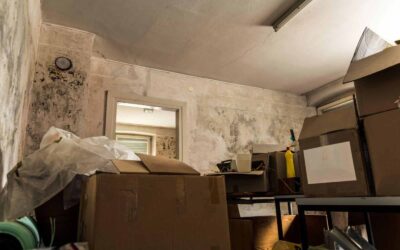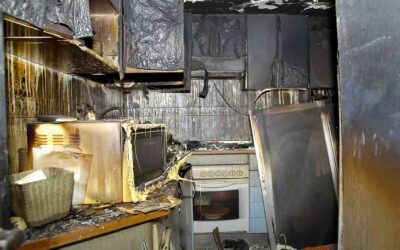When a fire occurs in a building, the damage it causes can often spread far beyond the areas that are directly affected by the flames. Superheated air, ash, and smoke can be just as devastating to a home and its contents. In the most severe cases, they can render the building entirely uninhabitable. It all happens very quickly, too, with a few sparks capable of growing into an out-of-control blaze within a matter of seconds.
While the devastation wrought by a blaze happens swiftly and dramatically, the fire restoration process that follows is usually slow and deliberate. That’s because particles of ash and smoke can spread to every nook and cranny in the home, scorching walls, blackening building materials, and encrusting delicate valuables in a thick layer of soot. Eliminating all traces of a blaze is an extremely challenging and time-consuming process.
At Biodynamic, we address the challenges inherent in the fire restoration process by employing advanced technology, including a cutting-edge method known as laser ablation. Now utilized for everything from surgical procedures to archeological excavations, laser ablation is one of the fastest and most effective ways to restore a building to its original pre-loss condition.
What Is Laser Ablation?
The term “ablation” is most commonly used in the medical field, where it refers to the process of removing damaged or diseased tissues during the process of surgery. When a medical professional performs a procedure that involves ablation, their goal is always to remove only the sick or injured cells, leaving the healthy ones unharmed.
This is also true of other applications of the ablation process: In a broader sense, it simply means to remove unwanted materials without damaging the underlying substrate. “Laser” ablation specifically refers to the use of lasers (essentially, intense pulses of light) to eliminate dirt, grime, soot, and ash without causing any harm to the items they have accumulated on.
How Does It Work?
When our professional services are secured for a fire restoration project, we bring a number of specialized pieces of equipment to assist with the job. If we determine laser ablation will be an effective restoration method for a particular task, we utilize large, semi-portable machinery that can generate the necessary wattage to create the laser light pulses used for laser ablation.
These machines have attached fiber optic cords that have focused elements at the ends. These allow the operators to target either large or small areas to perform the cleaning process. Operators wear safety gear, including heavy-duty eye protection, to perform their tasks without placing themselves at risk as they work.
The portability of laser ablation machines means they can be used to access essentially any area of a building. This is important during the restoration process because, as we mentioned previously, the smoke created by an out-of-control fire can suffuse absolutely every area that it reaches.
When Is Laser Ablation Useful?
Since the primary application of laser ablation is to remove unwanted layers of material from a surface, it is excellent for removing soot, char, and (often toxic) surface contaminants from a given area. It’s particularly suited for removing these materials from particularly delicate surfaces since the ablation process vaporizes only the top layer of coverage, and it does so without applying excess heat or otherwise damaging the material underneath.
After a fire, particularly one in a home, there are often many delicate areas that require special attention due to becoming covered in ash and soot. These include artwork, electronic equipment, and other items that would not be able to withstand the harsh cleaning products used during traditional restoration projects.
Because it’s a non-contact method of cleaning, laser ablation also works excellently for removing all traces of fire from building materials that would be at risk of damage were they to be subjected to abrasive scrubbing or strong cleaning chemicals. These include wood, brick, and many types of metal. For this reason, laser ablation is frequently utilized during the process of restoring historically significant buildings, where it is especially crucial to avoid damaging the building materials as they are cleaned.
Environmentally Friendly Cleaning
A fire in a structure usually leaves behind a great deal of toxic residue released from building materials such as plastic and chemically treated wood. Removing this residue without creating more toxicity is a matter of minimizing the use of chemical cleaners. When chemically based cleaning products are used, they inevitably end up entering the local environment, where they may place people and pets at risk.
Utilizing laser ablation helps to reduce the presence of toxic materials in the areas surrounding a building. Not only is this a more environmentally friendly method of fire restoration, but it greatly reduces unnecessary risks to the inhabitants of a building. This is particularly critical after a fire has spread contaminants throughout a location.
Recovering After a Fire
Laser ablation is only one of the many methods we utilize to help return homes to their pre-loss condition after a blaze has occurred. Our goal is to remove all traces of the fire, and laser ablation machinery helps to eliminate many of the signs, particularly accumulated soot and ash. The Biodynamic team also utilizes other state-of-the-art technology for fire damage restoration, including dry ice blasting, non-toxic cleaners, and BioSweep odor removal. The restoration process also includes performing a meticulous inventory of the items and property that is to be restored, boarding up and tarping affected areas to prevent further damage, and rebuilding services where necessary.
If you or someone you know has been affected by a fire in their building, we’d like to help. Contact Biodynamic to discuss the restoration process so that you can return to normal life as quickly as possible.


